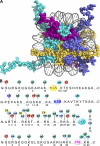Chemical approaches for studying histone modifications
- PMID: 20147749
- PMCID: PMC2856977
- DOI: 10.1074/jbc.R109.080291
Chemical approaches for studying histone modifications
Abstract
Histones form the protein core around which genomic DNA is wrapped in eukaryotic chromatin. Numerous genetic studies have established that the structure and transcriptional state of chromatin are closely related to histone post-translational modifications. Further elucidation of the precise mechanistic roles for individual histone modifications requires the ability to isolate and study homogeneously modified histones. However, the highly heterogeneous nature of histone modifications in vivo poses a significant challenge for such studies. Chemical tools that have enabled biochemical and biophysical studies of site-specifically modified histones are the focus of this minireview.
Figures




Similar articles
-
Studies of biochemical crosstalk in chromatin with semisynthetic histones.Curr Opin Chem Biol. 2018 Aug;45:27-34. doi: 10.1016/j.cbpa.2018.02.005. Epub 2018 Feb 27. Curr Opin Chem Biol. 2018. PMID: 29494828 Free PMC article. Review.
-
Chemical approaches to understand the language of histone modifications.ACS Chem Biol. 2011 Oct 21;6(10):987-99. doi: 10.1021/cb200142c. Epub 2011 Aug 17. ACS Chem Biol. 2011. PMID: 21827195 Free PMC article. Review.
-
Chemical tools in chromatin research.J Pept Sci. 2010 Oct;16(10):530-7. doi: 10.1002/psc.1226. J Pept Sci. 2010. PMID: 20862720 Review.
-
Synthetic post-translational modification of histones.Curr Opin Chem Biol. 2018 Aug;45:35-47. doi: 10.1016/j.cbpa.2018.02.004. Epub 2018 Feb 28. Curr Opin Chem Biol. 2018. PMID: 29501025 Review.
-
Identification of novel histone post-translational modifications by peptide mass fingerprinting.Chromosoma. 2003 Aug;112(2):77-86. doi: 10.1007/s00412-003-0244-6. Epub 2003 Jul 9. Chromosoma. 2003. PMID: 12937907
Cited by
-
Epigenome mapping in normal and disease States.Circ Res. 2010 Aug 6;107(3):327-39. doi: 10.1161/CIRCRESAHA.110.222463. Circ Res. 2010. PMID: 20689072 Free PMC article. Review.
-
Identification and interrogation of combinatorial histone modifications.Front Genet. 2013 Dec 20;4:264. doi: 10.3389/fgene.2013.00264. Front Genet. 2013. PMID: 24391660 Free PMC article. Review.
-
Reference gene selection for quantitative reverse transcription-polymerase chain reaction normalization during in vitro adventitious rooting in Eucalyptus globulus Labill.BMC Mol Biol. 2010 Sep 20;11:73. doi: 10.1186/1471-2199-11-73. BMC Mol Biol. 2010. PMID: 20854682 Free PMC article.
-
Cleavable and tunable cysteine-specific arylation modification with aryl thioethers.Chem Sci. 2021 Feb 18;12(14):5209-5215. doi: 10.1039/d0sc06576e. Chem Sci. 2021. PMID: 34168774 Free PMC article.
-
Mechanisms underlying epigenetic and transcriptional heterogeneity in Chinese hamster ovary (CHO) cell lines.BMC Biotechnol. 2016 Jan 22;16:6. doi: 10.1186/s12896-016-0238-0. BMC Biotechnol. 2016. PMID: 26800878 Free PMC article.
References
Publication types
MeSH terms
Substances
LinkOut - more resources
Full Text Sources
Other Literature Sources

